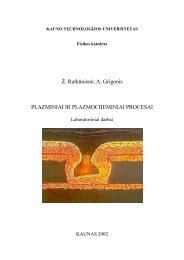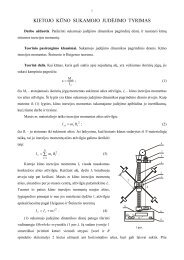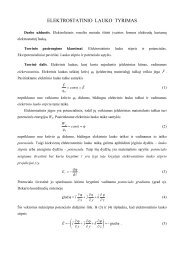PROCEEDINGS OF THE 7 INTERNATIONAL ... - Fizika
PROCEEDINGS OF THE 7 INTERNATIONAL ... - Fizika
PROCEEDINGS OF THE 7 INTERNATIONAL ... - Fizika
Create successful ePaper yourself
Turn your PDF publications into a flip-book with our unique Google optimized e-Paper software.
MEDICAL PHYSICS IN <strong>THE</strong> BALTIC STATES 7 (2009)<br />
Proceedings of the International Conference “Medical Physics 2009”<br />
9 - 10 October 2009, Kaunas, Lithuania<br />
QUALITY ASSURANCE PROGRAMS FOR A LINEAR ACCELERATOR<br />
Carl MAGNUS NILSSON<br />
Medical Radiation Physics Malmö, Lund University, Malmö University Hospital, SE-205 02 Malmö, Sweden<br />
Abstract: Quality Assurance (QA) is a comprehensive method for evaluation of an accelerator’s performance. It<br />
involves tools aiming at getting a correct absorbed dose to the patient and a good uptime. Daily, weekly, monthly and<br />
yearly checks of an accelerator are needed for a good surveillance of the accelerator. An acceptance test is done to<br />
check that the accelerator at delivery is within specified limits. The parameters are later checked within different<br />
timeframes to see if the values keep within a specified limit, and if not then corrected. The QA and Quality Control<br />
(QC) of the accelerators at Malmö University Hospital are described.<br />
Keywords: Quality Assurance, Quality Control, Acceptance Test, Clinical Linear Accelerator<br />
1. Introduction<br />
Linear accelerators has undergone a tremendous<br />
development since their introduction in the 1950s, and<br />
are now equipped with multiple interlocks, automatic<br />
change between photon and electron mode, multileaf<br />
collimators (MLC), moving collimators, etc. The QC<br />
has to check all parts of the system. It is the<br />
responsibility of a clinical physicist to coordinate the<br />
QC work. Some work can be delegated to e.g.<br />
radiographers since they are regular users of the<br />
accelerator. This paper will give an introduction to QA<br />
and QC at Malmö University Hospital and the following<br />
points will relate to different aspects of QC and the<br />
responsible personnel.<br />
2. Quality Control<br />
Acceptance Test [1]<br />
During the installation of an accelerator the medical<br />
physicist must assure that the facility is properly<br />
prepared. This may include: (1) installing the proper<br />
warning signs, (2) assuring that the appropriate audio<br />
and video equipment is installed to monitor the patients,<br />
(3) assuring that the appropriate door interlocks are in<br />
place and connected properly and assuring that the<br />
emergency power failure illumination is installed or<br />
available (e.g. flashlights).<br />
As soon as the accelerator can deliver radiation, a beam<br />
safety tests should be the first thing on the agenda and<br />
to perform tests of the safety interlocks, determination<br />
of radiation exposure levels outside barriers and<br />
determination of exposure levels in the occupied areas<br />
during beam-on.<br />
Initial checking of mechanical and radiation systems is<br />
to commence after this. Alignment of collimator axis<br />
60<br />
and collimator jaws has to be made. The collimator axis,<br />
the light localizer axis and cross hairs must all be<br />
congruent and follow the same axis and this must be<br />
checked for all ranges of motions. When this is within<br />
the specified limits, the light field and radiation field<br />
congruence and coincidence must be verified. This can<br />
be done by exposing two films with collimators rotated<br />
180 ◦ . Congruence and symmetry must be verified over<br />
the full range of both collimator and gantry positions.<br />
The mechanical and radiation isocenter location should<br />
then be determined to be within the specified limits.<br />
Other mechanical system tests must also be performed.<br />
The patient support system (couch) must be tested to<br />
assure that it’s flex, both with and without load is within<br />
the specified limits and that the couch is able to take the<br />
maximum weight, that the couch stops at the right<br />
positions and hold the position and the coordinates of<br />
the table are within specified limits.<br />
At commissioning of an accelerator it is necessary to<br />
establish that the beam profile conforms to the<br />
accelerator’s specifications. This should be done in a<br />
water phantom making measurements at least close to<br />
maximum and at 10 cm deep, and other specification<br />
depths at which the profile is specified.<br />
Variation of output with different field sizes is also a<br />
parameter that is required at commissioning. Depth<br />
doses and profiles are also measured for different field<br />
sizes.<br />
The manufacturers often have documents with tests to<br />
perform, and the documents should be reviewed to see<br />
which additional tests are needed.<br />
After the acceptance test, the commissioning can<br />
commence which includes beam data acquisition, entry








